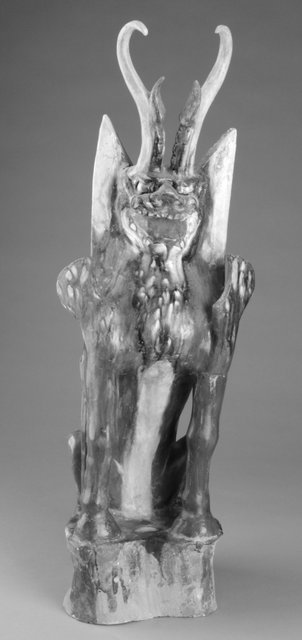- Print article
- Download PDF 531kb
Recent Museum of Art Acquisition:Tang Dynasty Tomb Sculpture
Skip other details (including permanent urls, DOI, citation information)
: This work is protected by copyright and may be linked to without seeking permission. Permission must be received for subsequent distribution in print or electronically. Please contact mpub-help@umich.edu for more information.
For more information, read Michigan Publishing's access and usage policy.

Squatting firmly on its haunches, this magnificent composite creature snarls a warning to all who are caught in the gaze of its bulging eyes. With its leonine body, bovine hooves, and antelope horns—not to mention winglike appendages and ears that would put Dumbo the Elephant to shame—this terrifying and witty image typifies the imaginative genius of Tang dynasty art. Along with a companion figure of similar form but with a humanoid face, this creature once guarded the interior of a tomb in northern China. Known as earth spirits, they shared the task not of keeping intruders from the tomb but rather of preventing its occupant from emerging to disturb the living (Kaikodo Journal 1977).
Texts dating back as far as the fifth century BCE refer to an already ancient practice of shamans wearing bearskins to drive away “demons of pestilence and plague,” which some scholars see as the ultimate ancestor of these composite earth spirits (Rogers 1998, 56). Sculptural representations of pairs of guardian figures, one with a human and the other with a bestial face, first appear in significant numbers in northern Chinese tombs almost a millennium later, in the fifth century. No satisfactory explanation has been offered for the emergence of this mortuary practice at this time, but Confucianism had lost much of its authority after the fall of the Han dynasty in 220 CE, and there was a general atmosphere of religious experimentation.
Guardian spirits continued to be important in Tang dynasty (618–907) tombs. Tang burial practices generally followed earlier precedent, but on a much grander scale. Tang nobles were buried in multichambered underground tombs, accompanied by clay replicas of a large retinue of companions and servants, as well as vessels of food and wine and heirloom objects. So great were the resources squandered on burial that the imperial court issued regulations to govern the size and contents of tombs, in accordance with the office and rank of the deceased. The largest figurines, over four feet, were reserved for members of the imperial family; this earth spirit, at nearly 28 inches tall, would have been for a high-ranking government official. It can be dated to the early eighth century by its muscular, realistic modeling and the masterful use of sancai glaze. The vivid expression, balanced proportions, and superb condition of this sculpture rank it among the finest of its type in an American museum collection.
Sancai (three-color) ware was the most technically complex of Tang ceramics. Amber and green glazes, colored with iron and copper respectively, were applied to a white clay body and fired at about 800 degrees Centigrade. In order for the glazes to melt at these low temperatures, large amounts of lead were added as a flux (an agent that lowers the melting temperature). In the finest works, the glazes run slightly together in an organic way, as here; at worst, the colors blur indiscriminately.
Both historical records and archaeological evidence show that sancai production began in the latter half of the seventh century but fell into sharp decline after a devastating rebellion in 756 CE. The provenance of this work is unknown, but the largest numbers of Tang sancai wares have been excavated from tombs in Xi’an and Luoyang—the western and eastern capitals of the dynasty (Wang 2002, 196).
Works Cited
Kaikodo Journal. 1977. Vol. 3, no. 34 (Spring): 124–125, 245–247.
Rogers, H. 1998. “Notes on the Meaning and Function of Ming-ch’i.” Kaikodo Journal 7 (Spring).
Wang, Q. 2002. A Dictionary of Chinese Ceramics. Singapore: Sun Tree Publishing.
Further Reading
Fong, M. H. 1991. “Tomb-Guardian Figures: Their Evolution and Iconography.” In Ancient Mortuary Traditions of China, ed. G. Kuwayama. Los Angeles: Los Angeles County Museum of Art.

